Raspberry leaves turn yellow in summer: what to do and why it happens
Yellowing, drying out and falling of leaves in autumn is a natural process, indicating that the plant is entering a state of dormancy. But if such signs are absolutely normal for autumn, then a yellowing crown in spring or summer is a serious problem.
The state of the leaves of the plant determines how comfortable it is. The appearance of yellow spots indicates improper care, a deficiency of nutrients or infection with diseases and pests. Consider why raspberry leaves turn yellow in summer and what to do to save it.
The content of the article
Causes of yellowing of raspberry leaves in summer
The yellowing of crimson foliage in summer or spring is not natural. The color of the leaves is used to judge the condition of the shrub. Yellow and dry spots are often the result of:
- lack of nutrients;
- improper care;
- diseases;
- pest attacks.
In most cases, when eliminating the cause of yellowing of the leaves, it is really possible to save raspberries... If the problem is running, you will need transfer and pruning damaged part of the bush. If the plant has completely shed its leaves, and its shoots have dried up, then it has died. In this case, the shrub cannot be restored.
Sometimes yellowed leaves indicate a viral infection of the shrub. Viruses cannot be treated. To save healthy plants, the affected ones will have to be removed from the site.
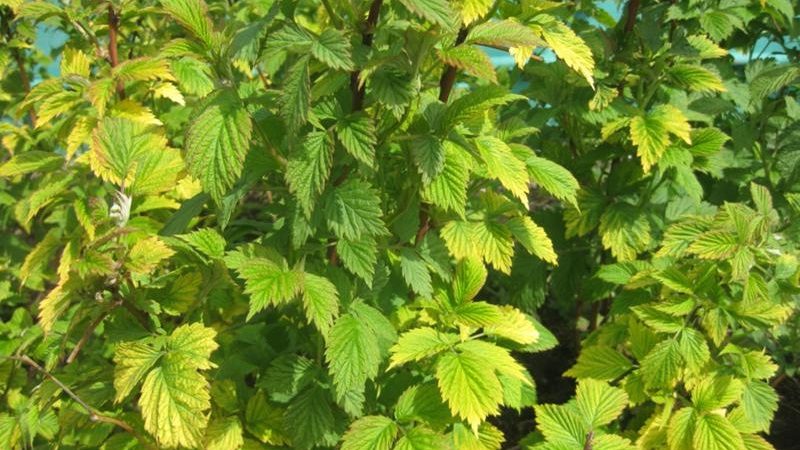
Lack of nutrients
Deficiency of micro- and macroelements leads to improper plant development... By the appearance of the leaves, it is determined which substance is missing.
Note! If the fertilizer application schedule is followed, there are no problems with a lack of nutrients.
With a lack of nutrients, yellow leaves appear in the summer, usually in June or July. Them appearance depends on the type of deficiency:
- Nitrogen... With an insufficient amount of nitrogenous fertilizers, the development of the plant slows down, its growth stops. The substance is responsible for photosynthesis; therefore, its lack leads to crushing, paleness and yellowing of the green mass. To save the plant, it is fed with nitrogen-containing agents, for example, ammonium nitrate.
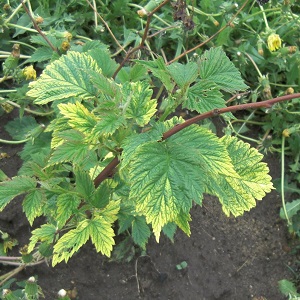 Sulfur... Its lack is expressed in a uniform blanching and then yellowing of the leaves. Over time, the petioles become thinner and fall off.
Sulfur... Its lack is expressed in a uniform blanching and then yellowing of the leaves. Over time, the petioles become thinner and fall off.- Iron... Iron deficiency is called chlorosis. Outwardly, its symptoms are very similar to those of jaundice, a viral disease. With chlorosis, the leaves turn first pale green, and then pale yellow, while the veins remain green. For treatment, drugs containing iron are used, for example, iron sulfate.
- Magnesium... With a lack of magnesium, the leaves turn yellow, wither, dry out and fall off prematurely. At the same time, spots appear in the center of the sheet plate, the edges turn yellow and wrap. To get rid of the problem, apply magnesium fertilizers, for example, magnesium sulfate.
- Calcium... With its pronounced deficiency, the edges of the leaves and shoots acquire a brown tint and die off. If the problem is not very severe, white or light yellow streaks and stripes appear on the sheet plates.
- Boron... With its lack, small dry spots appear, which gradually increase in size. Hollowness of the shoots is observed. Yellowish leaves appear, which dry quickly. Boron deficiency often results from a lack of potassium.
- Zinc... Spots of a gray-yellow hue appear on the leaf plates. Their number increases rapidly, they merge. The greens are crumbling.
Lack of nutrients is fought in two ways... The first option is to use only the substance that the plant needs. To do this, it is important to correctly identify the type of deficiency, since an excess of certain substances is also dangerous. An easier way is to use complex fertilizers.
Diseases
Another reason why raspberry foliage turns yellow is disease. Most infections kill the plant without timely treatment, some do not heal at all. When one plant is infected, the infection is quickly transferred by wind and insects to other crops.
Diseases are most effectively treated in the early stages. The more advanced the infection, the higher the likelihood of the death of raspberries.
Infectious chlorosis
Viral chlorosis is also called raspberry jaundice. Symptoms of the disease resemble iron deficiency. They identify the problem by the following signs:
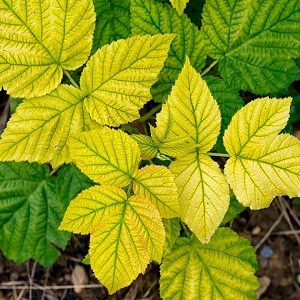 Yellow leaves appear on young and biennial branches. On the shoots, the leaves in the upper part are most affected. At the same time, at first on the yellow leaf plate, the veins remain green, but then they also turn yellow. Foliage gradually becomes smaller, but its shape does not change.
Yellow leaves appear on young and biennial branches. On the shoots, the leaves in the upper part are most affected. At the same time, at first on the yellow leaf plate, the veins remain green, but then they also turn yellow. Foliage gradually becomes smaller, but its shape does not change.- Shoots, fruit petioles, stalks, sepals, fruiting brushes acquire a yellow tint. Annual shoots are stretched, become weak.
- The berries of the affected plant also change - they become smaller, become less juicy, with an unexpressed taste.
Symptoms are most pronounced at the time of fruit setting and ripening, and after harvest, the crown turns green, and the signs practically disappear. The disease again makes itself felt in the fall. The next year everything repeats itself.
The viral disease is not treatable... When its signs are found, the raspberries are dug up, taken away from the site and burned.
To prevent infection, they follow the rules of prevention:
- The choice of healthy planting material. It is best to choose varieties that are resistant to jaundice.
- Timely prevention and elimination of pests. The bushes are regularly examined and treated with aphids and spider mites, which contribute to the spread of the disease.
- Sanitary pruning. Shoots thickening the crown, dry and old branches, parts of the plant with damaged bark are removed.
- Compliance with the schedule for the introduction of mineral and organic fertilizers. It boosts the immunity of raspberries.
- Planting raspberries on a site where the same culture grew no less than 5 years ago.
Root cancer
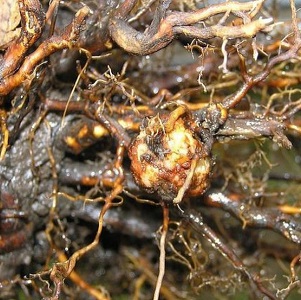 Root cancer is also called root goiter.... This is a bacterial disease that is provoked by a dry climate, alkaline soil, long-term cultivation of shrubs in the same place.
Root cancer is also called root goiter.... This is a bacterial disease that is provoked by a dry climate, alkaline soil, long-term cultivation of shrubs in the same place.
Bacteria enter the structure of the plant through cracks in the roots. On the root processes, growths are formed with a diameter of 10 to 12 cm. Sometimes they also touch the root collar. Gauls (the so-called growths) have an irregular shape, at first they are soft, then gradually harden.
Due to root cancer, the roots no longer fully absorb liquid from the soil... The plant begins to suffer due to a lack of nutrients: the leaves turn yellow, wither, dry out, new shoots develop poorly, turn out to be short, the fruits become smaller, lose moisture.
Advice! To make sure the diagnosis is correct, dig up the roots of the raspberry and check for growths.
Root cancer is not cured... Affected plants are dug up and burned. The soil at the site is treated with copper sulfate to prevent contamination of other plants. In a place that has been affected by the disease, no other shrubs can be planted for 3 years. Better to plant it with lupine to improve the soil.
To avoid infection, before planting, the soil and roots of the planting material are treated with copper sulfate. The garden is cleaned in autumn. Be sure to check the acidity of the soil.
Rust
Rust is a fungal disease... It is spread by conifers, some weeds. Fungal spores are especially active in warm and humid weather.
Rust symptoms:
- In the second half of spring, the inner side of the leaf plates is covered with small red pads with spores. Small yellow spots are formed on the outside.
- Gradually, the spots and pads with spores increase in size.
- The pads burst, spores come to the surface. Some of them cover the entire lower surface of the leaves, the other part scatters around the garden.
- Rusty leaves dry from the edges to the center.
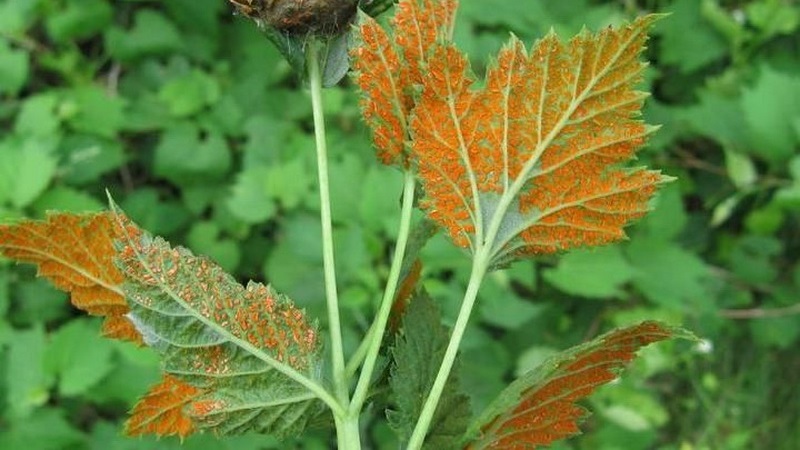
The yield of the raspberry bush falls, the fruits become tasteless... The winter hardiness of the plant is significantly reduced.
Control methods:
- The most affected leaves, which have already begun to fall asleep and are covered with a thick spore layer, are cut off.
- The plant is treated with fungicides ("Topaz", "HOM") according to the instructions. Re-treatment is usually required at intervals of 2-3 weeks.
- To prevent the disease, before the buds bloom, the bush is sprayed with a solution of copper sulfate (1 tablespoon per bucket of water) or Bordeaux liquid.
Ring spot
Ring spot is another viral disease. Its first signs appear one year after raspberry infection.:
- Patterns of pale yellow or yellow-green in the form of rings appear on the leaves. This usually happens in the first half of summer. At the end of July - August, the signs often disappear, but by autumn they reappear.
- The bush or individual shoots are lagging behind in development. The branches become short and fragile, and die off quickly.
- The fruits are undeveloped, dry out quickly. Sometimes, against the background of the disease, new ovaries begin to develop in the fall.

The disease does not respond to treatment... Affected raspberries are dug up, carried away from the site and burned. To prevent the appearance of ring spot, varieties resistant to it are grown, only healthy plants are planted. The soil is treated from nematodes - possible vectors of the disease.
Late blight
Late blight is a fungal disease that affects raspberry roots... For a long time, the disease practically does not manifest itself. Only at advanced stages does the foliage quickly turn yellow, and soon the bush dies.
To treat the disease, the soil around the raspberries is watered with a solution of copper sulfate or diluted according to the instructions with fungicides. In this case, folk remedies are ineffective, since the disease makes itself felt in the later stages of development. To prevent infection, preventive treatment with copper sulfate is carried out.
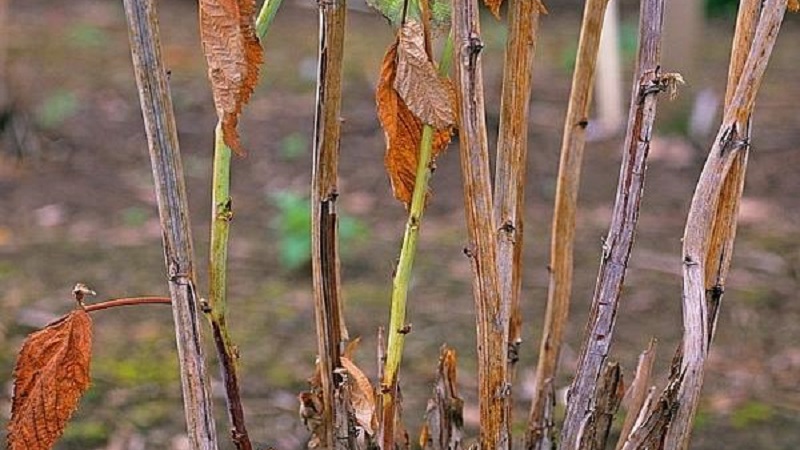
Curly
Leaf curl is a viral disease that can kill an infected plant in 3 years. Recognize the disease by such signs:
- The leaves become hard and small, deformed, and wrinkled. The underside takes on a brown tint.
- The leaves are curled inward. This makes the plant look curly.
- The berries are sour and dry, deformed.
Shrubs affected by curl do not respond to treatment... Such raspberries are dug up, carried away from the site and burned.
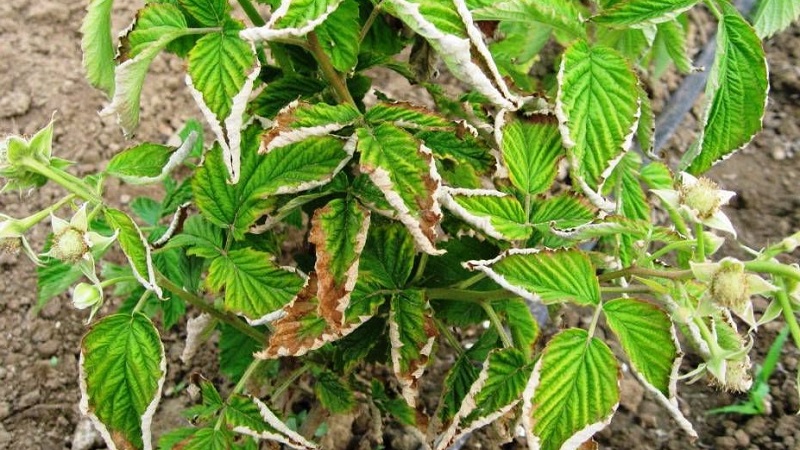
Pests
Pests often cause yellow leaves.... Usually, this effect occurs when insects attack, sucking juice from greens.
Aphid
These small insects settle on young shoots and raspberry leaves in whole colonies... They come in green, brown, gray and black. There are individuals with and without wings.
Aphids suck the sap from the plant. Affected leaves wither, turn yellow, dry up and fall off... It is easy to find a pest by examining raspberries.
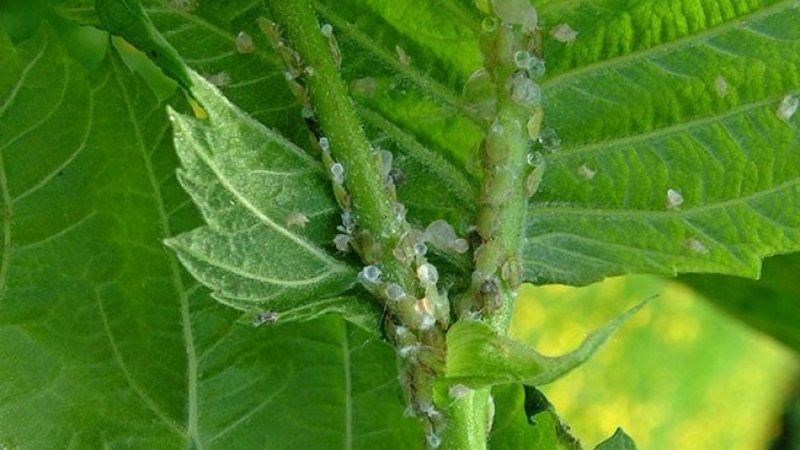
To get rid of aphids, the affected shrub is treated with insecticides. ("Karbofos") or folk remedies:
- Soap-ash solution. A piece of laundry soap and 1 kg of ash is dissolved in a bucket of water. The product is allowed to brew for a day, then used for spraying. It is recommended to water the soil around the bush.
- A decoction of bitter herbs: wormwood, dandelion greens, yarrow.
- Onion and garlic solution. Grind 0.5 kg of onion and 0.2 kg of garlic in a meat grinder. The gruel, together with the peel, is poured with a bucket of water and insisted for 3 days. Then the affected plants are filtered and sprayed.
Spider mite
Another pest is the spider mite. These are small insects of black, green, yellow or red color..
Advice! To find a tick, look at the back of the leaves. On them you can see a cobweb in which the larvae of the pest are located.
Affected foliage curls inward, turns yellow and fades.
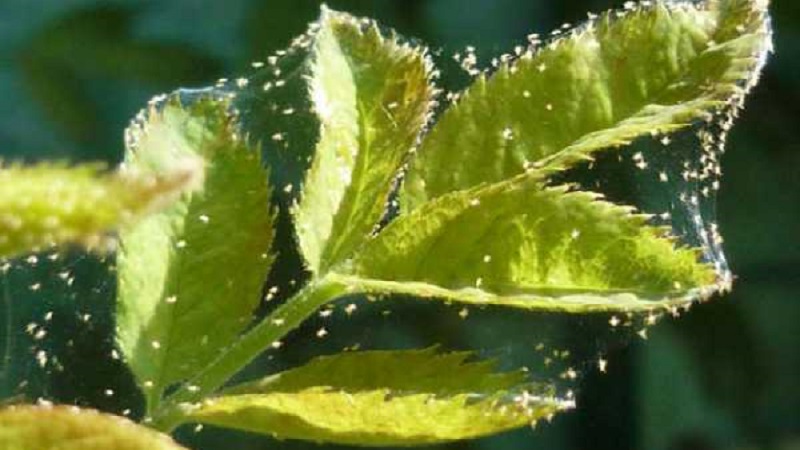
Fight spider mites like aphids... Apply insecticides or folk remedies.
Agrotechnical errors
Although raspberries are a hardy and unpretentious shrub, violation of agricultural technology affects its condition... The problem arises from improper care, incorrect selection of a site for planting or unfavorable climatic conditions.
Agrotechnical mistakes that cause yellowing of leaves:
- Thickening the bush... Such a mistake becomes the cause of poor air exchange, insufficient intake of nutrients, stagnation of moisture on the leaves, which provokes yellowing of the foliage, infection with a fungal infection. Annual sanitary and formative pruning, maintaining a distance of at least 1.5 m when planting plants, will help to avoid problems. When the bush thickens, the crown is thinned out, removing all branches directed inward and root shoots.
- Lack of moisture... In this case, the leaves begin to turn yellow and fall off. In a dry summer, raspberries are watered once every 1-2 weeks, spending 10-30 liters of water per bush. Mulching the trunk circle will help to reduce the number of waterings and reduce the risk of liquid deficiency.
- Increased acidity of the soil... A slightly acidic soil is suitable for raspberries. If the acidity values are increased, dry alkali or ash is added at the rate of 1 kg per 1 m².
- Excess moisture... The problem often arises during periods of prolonged rainfall. Mulching the soil by watering with a solution of copper sulfate will help save the plant. Excess fluid often leads to the leaching of nutrients. In this case, additional fertilization will be required.
How to save raspberries
If the raspberry leaves began to turn yellow, it is first of all important to check the bush for diseases and pests.... Even if there are no obvious signs, several preventive treatments with copper-containing preparations (copper sulfate solution) are carried out.
If signs of illness are absent, care is reviewed... It is important that the soil around the bush does not dry out, but the liquid does not stagnate either. The soil is mulched. The plant is fed with complex mineral fertilizers. After a month, organic top dressing.
Attention! The reasons for the yellowing of remontant and simple raspberries are the same. However, plants that produce 2 crops per year are most often deficient in nutrients. After collecting the first harvest, a complex feeding is mandatory.
If all the conditions of care are met, and signs of disease are not found, but raspberries still turned yellow, the bush is transplanted, having previously examined the roots. Another way to save the plant is to do anti-aging pruning.
Preventive measures
To prevent premature yellowing of raspberry leaves, it is important to create optimal conditions for it. Prevention rules:
- Choosing healthy seedlings... Before planting, they are examined for traces of diseases and pests: spots, holes, cracks in the bark, curvatures, growths on the shoots and the root system.
- Disinfection of seedlings, soil and garden tools. Preventive treatments solution of copper sulfate in the spring before the buds open and in the rainy season.
- Timely watering, mulching the soil to prevent moisture stagnation.
- Fertilization at least 3 times a year. Usually raspberries are fed in spring, summer and autumn, before wintering.
- Formative and sanitary pruning... Cutting root growth.
- Autumn garden cleaning... Fallen leaves and other plant residues are removed and burned.
Conclusion
Premature yellowing of raspberry leaves is a dangerous symptom that indicates improper agricultural practices, a lack of micro- and macroelements, and infection of the bush with diseases and pests.
To cope with the problem, the plant is carefully examined for traces of diseases and insects, and the correct care is checked. After that, all possible causes are eliminated.